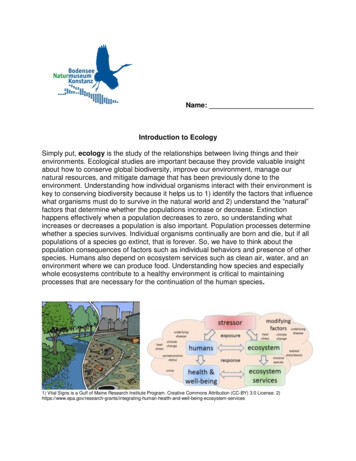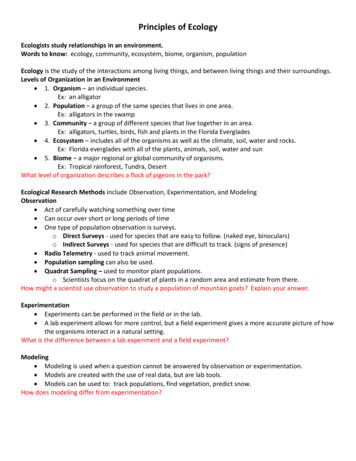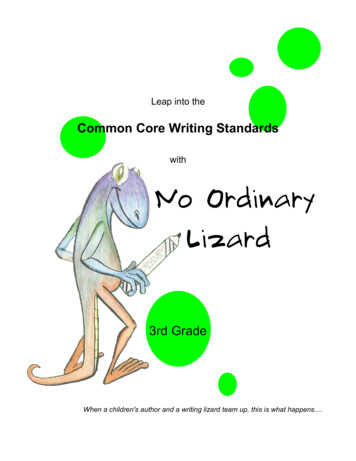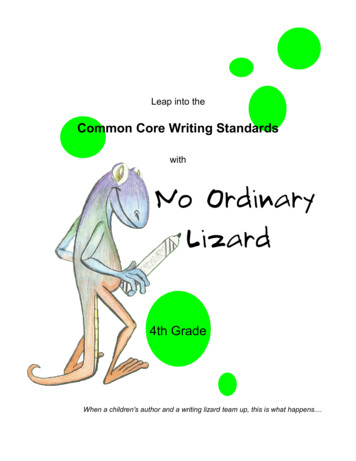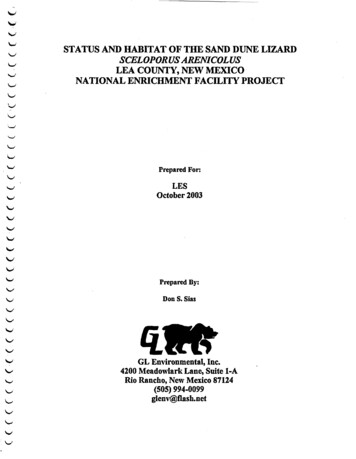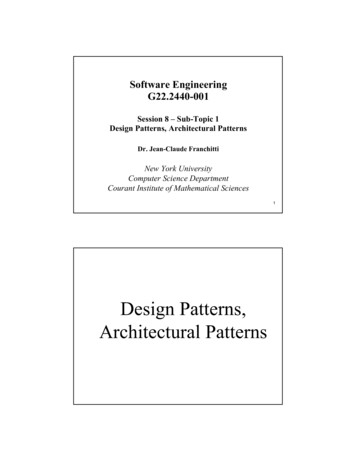
Transcription
The Biology of Lacertid lizards. Evolutionary and Ecological Perspectives (2004). Pérez-Mellado, V., Riera, N. andPerera, A. (eds.). Institut Menorquí d’Estudis. Recerca, 8: 139-157.HISTORICAL PATTERNS IN LIZARD ECOLOGY: WHATTEIIDS CAN TELL US ABOUT LACERTIDSVITT, L. J.1 & PIANKA, E. R.2Abstract: Lacertid, teiid, andgymnophthalmid lizards share much of theirevolutionary history. We explore ecologicaltraits of these lizards in an attempt toidentify similarities that may have ahistorical origin as well as differences thatmay reflect the effects of differing ecologicalsettings on the portion of their histories thatis independent. Within Teioidea, majordivergence in body size occurred producingGymnophthalmidae (small size) and Teiidae(larger size). Small body size ingymnophthalmids affected their ecologydifferently than larger body size did in teiids,particularly in respect to thermal ecology.Teiids maintain higher body temperaturesand are more successful in open, hot habitatsthan are gymnophthhalmids. Body sizevaries from small to relatively large inlacertids. A striking difference betweenlacertids and their sister clade, Teioidea, isthe inclusion of many ants in the diets ofsome species. Differences in data collectionmake direct comparisons between lacertids,gymnophthalmids, and teiids difficult. Wedemonstrate, with data on three lizardspecies, how interpretations based onnumerical versus volumetric dietary datavaries depending on how specialized aparticular lizard species is. We recommendstandardization of data collection suchthat future comparisons can be moremeaningful.Keywords: Lacertidae, lizard diets,lizard ecology, historical ecology, phylogeny,Teiidae.Resumen: Patrones históricos en laecología de lagartos: Qué nos enseñan losteidos acerca de los lacértidos. -Lacertidae,Teiidae y Gymnophthalmidae compartengran parte de su historia evolutiva. Exploramos los rasgos ecológicos de estos lagartos enun intento para identificar las similitudesque pudieran tener un origen histórico, asícomo las diferencias que puedan reflejarambientes ecológicos diferentes durante laporción independiente de sus historias evolutivas. Dentro de Teioidea, la mayor divergencia se prudujo en tamaño corporal,dando lugar a Gymnophthalmidae (pequeñotamaño) y Teiidae (gran tamaño). El pequeño tamaño corporal de los gimnoftálmidosafectó a su ecología de modo diferente acomo lo hizo el tamaño corporal grande enlos teidos, particularmente en relación a laecología térmica. Los teidos mantienen temperaturas corporales más altas y tienen máséxito en los hábitats abiertos que los gimnoftálmidos. En los lacértidos el tamaño varíadesde tamaños corporales pequeños a relativamente grandes. Una diferencia llamativa1 Sam Noble Oklahoma Museum of Natural History and Zoology Department, University of Oklahoma,Norman, OK 73072.2 Section of Integrative Biology (C0930), School of Biological Sciences, University of Texas at Austin, 1 UniversityStation, Austin, TX 78712-0253.139
VITT, L. J. & PIANKA, E. R.entre los lacértidos y su grupo hermano, losTeioidea, es la inclusión de numerosas hormigas en la dieta de algunas especies. Lasdiferencias existentes en el modo de obtenerlos datos hace que las comparaciones entrelacértidos, gimnoftálmidos y teidos sean difíciles. Demostramos con datos de tres especies de lagartos de qué modo las interpretaciones basadas en datos de dieta numéricos ovolumétricos varían dependiendo de lo especializada que sea una especie particular delagarto. Recomendamos una estandarizacióndel modo de obtención de los datos deforma que las futuras comparaciones puedanser más relevantes.Palabras clave: Lacertidae, dieta delagartos, ecología de lagartos, ecología histórica, filogenia, Teiidae.d’obtenció de dades fa que les comparacionsentre lacèrtids, gimnoftàlmids i teiids siguindifícils. Demostrem amb dades de tresespècies de llangardaixos de quina manerales interpretacions basades en dades de dietanumèriques o volumètriques variendepenent de com d’especialitzada siguiuna espècie particular de llangardaix.Recomanem una estandardització del moded’obtenció de dades, de manera que lesfutures comparacions puguin ser mésrellevants.Paraules clau: Lacertidae, dieta delsllangardaixos, ecologia dels llangardaixos,ecologia històrica, filogenia, Teiidae.INTRODUCTIONResum: Patrons històrics en l’ecologiadels llangardaixos: Què ens ensenyen elsTeiidae sobre els lacèrtids.- Lacertidae,Teiidae i Gymnophthalmidae comparteixengran part de la seva història evolutiva. Hemexplorat els trets ecològics d’aquestsllangardaixos en un intent d’identificar lessimilituds que poguessin tenir un origenhistòric, així com les diferències que podenreflectir ambients ecològics diferents durantla porció independent de les seves històriesevolutives. Dins de Teioidea, la divergènciamés gran es va produir en talla corporal,donant lloc a Gymnophthalmidae (petitamida) y Teiidae (mida gran). La petita tallacorporal dels gimnoftàlmids afectà la sevaecologia de manera diferent a com ho vafer la talla corporal gran dels teiids,particularment en relació a l’ecologiatèrmica. Els teiids mantenen temperaturescorporals més altes i tenen més èxit enhàbitats oberts que els gimnoftálmids. En elslacèrtids la grandària varia des de tallescorporals petites a relativament grans. Unadiferencia aparent entre els lacèrtids i el seugrup germà, els Teioidea, és la inclusió denombroses formigues en la dieta d’algunesespècies. Les diferencies existents en el modeThe set of evolutionary changesthat produced the common ancestor tothe Scleroglossa set the stage for acascade of events giving rise to thehighly divergent Gekkota andAutarchoglossa (PIANKA & VITT, 2003;V IT T et al., 2003). Although bothoriginated on Gondwana, the primarydiversification of Autarchoglossaoccurred on Laurasia (E STES , 1983).Thus, throughout the early evolutionaryhistory of autarchoglossans in the OldWorld, they coexisted with iguaniansand gekkotans. However, the NewWorld experienced early diversificationof iguanians prior to the arrival ofautarchoglossans that gave rise to teiidsand gymnophthalmids (ESTES, 1983).Divergence in prey capture,chemosensory abilities, and activitylevels likely provided scleroglossans newevolutionary options. Jaw prehensionfreed the tongue from involvement inprey capture (S CHWENK , 2000,SCHWENK & WAGNER, 2001), the skull140
HISTORICAL PATTERNS IN LIZARD ECOLOGYindependently several times within theGymnophthalmidae and appearsassociated with subterranean habits (seePELLEGRINO et al., 2001).Teioidea are often abundant interrestrial and some subterraneanhabitats, but rare in vegetation off theground. Even considering exceptionssuch as the partially arboreal species ofKentropyx in South America (e.g., VITT& CARVALHO, 1992), Teioidea achievetheir greatest success in terrestrialenvironments. High activity levels aresupported by high body temperatureswhile active, indeed, some of the highestactivity body temperatures amonglizards occur in the Teiidae (e.g., CASASANDREU & CURROLA-HIDALGO, 1993;S CHALL , 1977). Achieving andmaintaining high body temperatures athigh latitudes and elevations is a majorchallenge for moderate to large-sizedectothermic vertebrates and may explainthe relatively low diversity or absence ofteiids in temperate zones and at highelevations. Many gymnophthalmidsoccur in the Andes (e.g., HILLIS, 1985;H ILLIS & S IMMONS , 1986; K IZIRIAN ,1995) and in shaded rainforest (AVILAPIRES, 1995) and operate at relativelylow body temperatures (e.g., VITT et al.,1998a, b).Because Lacertidae is the sistertaxon to the Teioidea, these clades sharemuch of their evolutionary history(Figure 1). Their present daydistributions, with Teioidea (Teiidae andGymnoph-thalmidae) restricted to theNew World and Lacertidae restricted tothe Old World, suggests that much oftheir post-divergence evolutionaryhistories are independent. Nevertheless,became more flexible (F RAZZET TA ,1983; ARNOLD, 1998; HERREL et al.,2000), and chemosensory systems wereenhanced (SCHWENK, 1993a, b, 1994;C OOPER , 1996a, b, 1997a, b): theseinnovations provided scleroglossans withnew opportunities for diversification ina terrestrial environment dominated bysedentary, sit-and-wait foraging lizardsin the Iguania. Autarchoglossans inparticular, with their relatively highactivity levels, appear to have flourishedin terrestrial environments (PIANKA &V ITT , 2003; V ITT et al., 2003).Nocturnality in an ancestor to theGekkota minimized historical interactionsbetween them and the primarily diurnaliguanians and autarchoglossans.Cladogenesis continued within iguanians,gekkotans, and autarchoglossans,producing lizard families recognizedtoday.Within autarchoglossans, Teioideastands out partially because of therelative consistency of body form amongspecies and partly because of theunusually high activity levels,particularly within Teiidae. Althoughscalation varies considerably, especiallyin gymnophthalmids, morphologicalvariation is relatively conservativeamong members of the Teioidea (seebelow), with the exception of severalsubterranean lineages within thegymnophthalmidae. Most terrestrial orsemi-arboreal species are elongate,fusiform, and have relatively long tails.Morphological evolution centers onelongation of the body and tail, usuallyassociated with an active terrestriallifestyle. However, extreme elongationalong with near limblessness and drasticreduction of the tail has occurred141
VITT, L. J. & PIANKA, E. R.attributes. We point out thatLacertiformes only comprises about7% of known squamates. Teiidscomprise 1.7%, lacertids 3.1%, andgymnophthalmids 2.3% of squamates.Among Lacertiformes, about 118 teiids,220 lacertids, and 160 gymnophthalmids are currently recognized(PIANKA & VITT, 2003).MATERIAL AND METHODSMost, but not all data summarizedhere stems from published studies onteiids, lacertids, and gymnophthalmids.We include some data on other lizardtaxa for comparison. Data includedherein were collected in a similar waymaking comparisons possible. Becausethis of course limits generality of anycomparisons, we also comment onspecific information from other lacertidstudies that are directly relevant to ourconclusions. We assembled a morphology data set containing the followingvariables: lizard snout-vent length (SVL)in mm, total mass in g, head width,head length, head height, body width,body height, hind leg length and foreleglength, all in mm for 11,726 individualsof 112 lizard species in 46 generadistributed among the familiesAmphisbaenidae, Anguidae, Corytophanidae, Gekkonidae, Gymnophthalmidae, Hoplocercidae, Iguanidae,Lacertidae, Leisiosauridae, Polychrotidae, Scincidae, Teiidae, Tropiduridaeand Xantusiidae. We restrict themorphological analyses herein to 6935individuals representing 41 species ofLacertoidea (23 gymnophthalmids, 12Figure 1. Phylogeny of the Scincomorpha showingapproximate number of species in each clade. Thephylogeny is based largely on SCHWENK (2001) andnumbers of species are taken from ZUG et al. (2001)with some modifications. Some relationships remaincontroversial (e.g., xantusiids, VICARIO et al. 2003)at a superficial level, teiids, and perhapssome gymnophthalmids, appear to beecological counterparts to lacertids. Inthis essay, we examine morphologicaltraits and ecology of teiid lizardsdrawing comparisons with studiedlacertids and some other lizard clades.We also examine evolutionary eventswithin teiids and search for similartrends in lacertids. Finally, based on theecological roles teiids have played inNew World lizard assemblages, weconsider some historical differencesamong subclades within theLacertiformes that might account forpresent day differences in ecological142
HISTORICAL PATTERNS IN LIZARD ECOLOGYteiids, and 6 lacertids), but we commenton how they compare with lizards ingeneral. We also assembled a data set onlizard body temperatures from ourstudies. Because we were only interestedin comparisons at higher taxonomiclevels, we did not examine potentialdifferences among taxa in relationshipsof body temperatures to substrate or airtemperatures. For perspective, weincluded data on gekkonoid andiguanian lizards. Thus, data for thisanalysis include 3889 individual bodytemperature measurements on 67 lizardspecies.Dietary comparisons presentproblems due to variation among studiesin data reported. Thus we restrict ourdietary analysis to our own data becausethey were collected similarly. Wecombined data on desert and rainforestlizards (see VITT et al., 2003 for details)and restrict the analysis to the sevenmost important prey categories byvolume. We examine differences amongthe three major lizard clades, Iguania,Gekkota, and Autarchoglossa.Finally, to demonstrate limitationsof basing conclusions on numericalversus volumetric dietary data, weprovide analysis of a data set on 448Ameiva ameiva, containing 27 preycategories, 165 Anolis fuscoauratuscontaining 22 prey categories, and 58Plica umbra containing 16 preycategories. These species were chosenbecause they represent different dietstrategies. One (A. ameiva) is a generalistthat eats a lot of termites numerically,another (A. fuscoauratus) is a dietarygeneralist that eats a lot of ants andsmall beetles numerically, and the third(P. umbra), is an ant specialist. Methodsfor dietary analysis can be foundelsewhere (e.g., VITT & ZANI, 1996).RESULTS AND DISCUSSIONSetting the evolutionary stageHigh activity levels, jaw prehensionof prey, a tongue designed to transmitchemical information from the externalenvironment to the lizard’s sensorysystem, and an active foraging modemust have given ancestors to autarchoglossans a competitive advantageover all small diurnal vertebrates with asit-and-wait foraging mode in a worldrich in invertebrates and smallvertebrates (PIANKA & VITT, 2003; VITTet al., 2003). Jaw prehension dates backto the ancestor of scleroglossans andprovided two primary advantages: 1) thetongue could be freed up for otherfunctions and 2) larger prey could bemanipulated. In autarchoglossans, thetongue is used to transmit chemicalsfrom the external environment to thelizard’s vomeronasal sensory system.Even though scleroglossans, andautarchoglossans in particular, arecapable of eating large prey, manycontinue to eat small prey (VITT et al.,2003). Sit-and-wait foraging lizards inthe Iguania depend upon vision for preydetection and pursue moving insects(HUEY & PIANKA, 1981) and prey arecaptured by lingual prehension(SCHWENK, 2000). Consequently, mostnonmobile or hidden invertebrates andvertebrates are likely undetected byiguanian lizards, and large-sized prey,143
VITT, L. J. & PIANKA, E. R.(ANCOVA slope test, F1, 4308 22.1, P 0.0001), species, and in some casessexes, the all-species relationship isrelatively tight. Some exceptions exist,but a vast majority of lizards in theLacertoidea are terrestrial active foragers.Teiids and Gymnophthalmids arerestricted to the new World and, withthe exception of a handful of species,they are terrestrial. The strikingexceptions are at opposite ends of a sizegradient. A few small gymnophthalmidslike Bachia (AVILA-PIRES, 1995; COLLI etal., 1998), Psilophthalmus, andProcellosaurinus (RODRIGUES, 1991a, b)are nearly limbless and liveunderground, and two of the largestteiid genera, Dracaena and Crocodilurusbask from elevated perches in trees overwater and forage in swamps, streams,and rivers (AVILA-PIRES, 1995; PIANKA& VITT, 2003).particularly vertebrates, would bedifficult to manipulate with the tongue.Poorly developed chemosensory systemsin iguanians did not allow thesophisticated prey discriminationexhibited by most scleroglossans, andautarchoglossans in particular (COOPER,1994a, b, 1995a, b; SCHWENK, 1993a,b; 1994). Nevertheless, several cladeswithin Iguania developed chemosensoryprey discrimination in response to aswitch to herbivory (C OOPER &ALBERTS, 1990, 1991).Teiids, gymnophthalmids, andlacertids comprise the Lacertoidea(Figure 1), a group of lizards generallycharacterized as elongate and fusiform.The conservative morphology of thesethree taxa is apparent in SVL to massregressions (Figure 2). Althoughsignificant differences in the SVL-massrelationships exist between clades4GymnophthalmidaeLacertidaeTeiidaeLog10 total mass3210–11.01.21.41.61.82.02.22.42.62.8Log10 snout-vent lengthFigure 2. Relationship between total body mass and snout-vent length in teiid, gymnopthalmid, and lacertid lizards.The outlier points falling below the regression are nearly limbless gymnophthalmid lizards in the genus Bachia144
HISTORICAL PATTERNS IN LIZARD ECOLOGYTeiid morphology and its consequences4-legged squamates so restrictive thatlarger deviations in length-massrelationships simply do not occur? If so,did a major physiological shift in theancestor of snakes open up newphysiological and ecological options?Even though the SVL - massrelationship in 4-legged squamates isconservative, interesting and in somecases surprising variation exists.Comparison of Teioidea with Iguaniareveals a significant difference in slopesof the SVL - mass relationship withTeioidea increasing in mass more as SVLincreases (F 1,7152 0.07, P 0.0142).Power of the slope test is high (0.69). Tobriefly summarize, gekkotans haveshifted away from an overall lizardBauplan by becoming relatively light inmass and Teioidea have shifted theopposite direction becoming slightlyheavier. This result may seem surprising,because one is immediately struck by theapparent streamlined nature of Teioideamorphology. Coupled with streamlinedmorphology in Teioidea is elongationand in many instances apparentthickening and lengthening of the tail,which can be important in locomotion(e.g., B ALLINGER et al., 1979). Thisprobably contributes to the added sizespecific mass. Higher size-specific massin Teioidea may partially account for thenearly clade-wide restriction to terrestrialmicrohabitats. Cost of locomotioncombined with an active lifestyle maylimit abilities of Teioidea to climb, ahypothesis that remains to be tested.Conservatism in morphologywithin Teioidea is reflected both incomparisons among subclades (Figure 2)and in comparisons among genera ofWe first comment on lizardmorphology in general because a broadperspective is necessary to interpretpatterns within the Lacertoidea. Weconcentrate on the SVL to total massrelationship even though someinteresting differences occur in othermorphological variables. Among thosespecies for which we had both SVL andmass data, a significant difference inslopes (ANCOVA with clade as the classvariable and log10 SVL as the covariate,F 2,9353 148.6, P 0.0001) existsamong Iguania, Gekkota, andAutarchoglossa. These clades do not fallon the same regression line. Slopes ofthe log-log relationships are: Iguania3.22, Gekkota 2.93, and Autarchoglossa3.22. Comparison of autarchoglossansand iguanians yields no difference inslopes or intercepts (F1,7754 0.07, P 0.7858; F1, 7754 1.09, P 0.2972) butthe power in both tests (0.058 and0.171, respectively) is low. Thusautarchoglossans and iguanians fall on asimilar but highly variable regression.Most of that variation is amongiguanians. An important, but notobvious point in the Iguania Autarchoglossa(lizardsonly)comparison is that SVL-specific mass iniguanians is attained primarily by arobust body whereas similar SVLspecific mass in many autarchoglossansis attained by a combination of bodyand tail elongation with mass of the tailcontributing greatly to overall mass. Weonly point that out here, but this raisesseveral interesting questions. Forexample, are physiological processes of145
VITT, L. J. & PIANKA, E. R.successful in terrestrial microhabitats.The Bauplan of many lacertids is similarto that of Teioidea (e.g., Figure 6), likelyreflecting success of the ancestralBauplan of lizards in the Lacertoidea.The most striking difference betweenLacertids as a group and Teioidea is thatteiid lizards (Figure 3). Whether one isexamining ecologically distinctgymnophthalmids (Figure 4) or teiids ofdrastically different body sizes (Figure5), the overall Bauplan is similar. Oneconclusion that can be drawn from thisis that the Teioidea Bauplan has provenLog10 total nambis21011.522.53Log10 snout-vent lengthFigure 3. Relationship between total body mass and snout-vent length in 5 genera of teiid lizards representingboth subclades (Teiinae and Tupinambinae)Figure 4. A. Vanzosaura rubricauda, a gymnophthalmid that lives in open habitats in central and southern SouthAmerica. B. Cercosaura ocellata, a gymnophthalmid that lives in leaf litter of the southern Amazon rainforest andnorthern Cerrado of Brazil146
HISTORICAL PATTERNS IN LIZARD ECOLOGYFigure 6. Male and female of the lacertid Podarcis siculafrom Menorca, Spain(e.g., P IANKA , 1994), resembling inmany ways, some of the larger teiids likeAmeiva, Tupinambis, Crocodilurus, andDracaena. The only Varanoidea thathave survived in the New World are inthe genus Heloderma (Helodermatidae)and their lifestyle is quite different fromthat of varanids, and their distribution islimited. Absence of small-bodied teiidsmay result from historical interactionswith the sister clade Gymnophthalmidae, most of which are small.Within Lacertidae, some species haveevolved small body size (e.g.,Takydromus) but in terms of the numberof small species, lacertids have not beennearly as successful at generating smallbodied species in the Old World asgymnophthalmids have been in the NewWorld. One hypothesis for thisdifference is that gymnophthalmids didnot encounter a diverse skink faunaduring their early evolutionary historywhereas lacertids did. Small-bodiedskinks have been very successfulthroughout the Old World and onPacific islands. Considering thatgymnophthalmids have done well insome relatively cool environments, oneFigure 5. A. The large-bodied teiid Tupinambislongilineus. B. The relatively small-bodied teiidKentropyx altamazonica. Both are from the Rio Ituxi inAmazonas, Brazil. Note the overall similarities inBauplan even though each is in a different subclade(Tupinambinae versus Teiinae) and mass differs by anorder of magnitudeno extant giant species of lacertids existand no diminutive species of Teiidaeexist. The smallest is Cnemidophorusinornatus, which, at a maximum SVL ofabout 69 mm, is still larger than mostgymnophthalmids. A few islandlacertids are large compared to others(e.g., Gallotia), but no morphological orecological equivalents of Tupinambis,Dracaena, or Crocodilurus exist in theLacertidae. The most likely explanationfor this may be the presence of varanidsthroughout much of the evolutionaryhistory of lacertids in the Old Worldand their absence throughout recenthistory of New World lizards. Varanidsare highly active and voracious predators147
VITT, L. J. & PIANKA, E. R.(1.006 and 0.904, respectively; F1, 4333 145.8, P 0.0001). Teiids haverelatively longer hindlimbs and thedisparity appears to increase withincreasing body size. Reasons for thisremain unknown, but several hypothesescan be proposed. Diversification ofteiids in the absence of varanids mayhave released them from evolutionaryconstraints on limb length allowingthem to diverge considerably from theTeioidea ancestor. Alternatively, lacertidhindlegs may have shortened in responseto a lack of iguanian diversity providingopportunities to use microhabitats thatdid not contain competitors historically.has to wonder why they did not colonizeNorth America. One possible reason isthat the only potential distributioncorridor, Central America, islongitudinally small and has onlyperiodically provided a connection toNorth America.Several other aspects of morphologyprovide insight into potential similaritiesand differences in ecology of lacertidsand teiids. We consider one here.Relative length of hindlimbs variesamong subclades within Lacertoidea(Figure 7). Slopes differ in therelationships between hindlimb lengthand SVL (F 2,5159 57.8, P 0.0001)amongsubcladeswithgymnophthalmids having the shortesthindlimbs, lacertids intermediate, andteiids the longest. Even though relativehindlimb lengths of teiids and lacertidsappear superficially similar in Figure 7,the regressions have different slopesTeiid activity and body temperaturesAll known lizard species in theLacertoidea are diurnal. Compared withother clades, teiids and lacertids tend tohave slightly higher body 2Log10 hindleg 2.62.8Log10 snout-vent lengthFigure 7. Relationship between SVL and HLL in families of the Lacertoidea148
HISTORICAL PATTERNS IN LIZARD ECOLOGYteiid-like in their thermal biology andactivities. In other environments,particularly high elevation environments, lacertid thermoregulationappears similar to that of high elevationiguanians (e.g., CARRASCAL et al., 1992;M ARTIN & S ALVADOR , 1993; V ANDAMME et al., 1987, 1990; BAUWENS etal., 1990, 1996). They maintainrelatively low body temperatures andbask considerably to gain heat. Thus,some lacertids have diverged from theirancestors in thermal physiology allowingthem to persist in Old World habitatssimilar to those dominated by iguaniansin the New World.and gymnophthalmids tend to haveslightly lower body temperatures (Figure8). Teiids in general and lizards in thegenus Cnemidophorus in particular, tendto have among the highest active bodytemperatures known in lizards, withsome exceeding 40 C (e.g., ASPLUND,1970; C ASAS -A NDREU & C URROLA HIDALGO, 1993; PIANKA, 1970; SCHALL,1977). Nevertheless, some desertlacertids appear to have equally highbody temperatures while active. Forexample body temperature of Nucrastessellata averages 39.2 2.8 C (PIANKA,1986). In some environments(particularly deserts), lacertids are veryDiets and foraging modeThe shift from lingual to jawprehension in scleroglossans withconcomitant enhancement of chemicalsensing (olfactory in Gekkota andvomeronasal in Autarchoglossa) set thestage for a major dietary shift (see VITTet al., 2003) that ultimately led to theevolution of extreme modifications ofthe jaw allowing ingestion of huge preyas seen in many varanoids (in particular,most snakes; GREENE, 1997). Chemicaldiscrimination of prey (e.g., COOPER,1990; 1994a, b; 1995a, b; 1997a, b)allowed 1) identification of highlyprofitable prey and 2) identification ofpotentially toxic prey. The obviousprediction is that scleroglossans shouldinclude less biomass of noxious insectssuch as ants in their diets and replacethose with insects of higher energycontent or those not producing noxiouschemicals. In general, this appears to bethe case (Figure 9). We were unable toFigure 8. Body temperatures of lizards in 6 clades149
VITT, L. J. & PIANKA, E. R.40NEOTROPICAL LIZARDSMean percent by volume3020100G TLS A B H40G TLS A B HG TLS A B HDESERT LIZARDS3020 —Note: delete"hymenopterans"hymenopterans100G TLS A B HG TIGUANIALS A B HGEKKOTAG TLS A B HAUTARCHOGLOSSASCLEROGLOSSAantsbeetlesotherFigure 9. Diets of Neotropical lizards (upper) and desert lizards (lower). Only the seven most important prey categoriesare shown. A dietary shift occurs in Scleroglossa with a reduction in proportions of ants and other noxious insects. Antsare replaced by a combination of grasshoppers, insect larvae, and spiders in Neotropical lizards and termites and spidersin desert lizards. Prey types are: (G) grasshoppers and crickets, (T) termites, (L) insect larvae, pupae, and eggs, (S)spiders, (A) ants, (B) beetles, and (H), non-ant hymenopterans. Many beetles, ants, and other hymenopterans producenoxious chemicals for defense (e.g., BLUM, 1981; EVANS & SCHMIDT, 1990). Modified and reprinted with permissionfrom the American Naturalisttest this hypothesis for lacertids ingeneral because, aside from ERP’s desertlizard studies, a vast majority of data ondiets of lacertids does not includevolumetric data. Most such studiesprovide counts of prey, and ants (andother hymenopterans) do constitute asignificant portion of the diet for manylacertids based on counts (e.g., CASTILLAet al., 1991; P ILORGE , 1982; P ÉREZ M ELL ADO et al., 1991; P ÉREZ M ELL ADO , 1998). One study thatcontained numeric and volumetric data(R OBINSON & C UNNINGHAM , 1978)revealed that two Namib lacertids haddiets in which ants and otherhymenopterans were not dominant. Inone, Meroles (formerly Aporosaura)anchietae, ants comprised 0.42% of thediet by volume and all hymenopteranscomprised only 5.19%. In the other,Meroles cuneirostris, ants comprised6.9% of the diet by volume and allhymenopterans comprised 16.5%. Thepossibility exists that ants eaten by manyEuropean lacertids do not contain150
HISTORICAL PATTERNS IN LIZARD ECOLOGYnoxious chemicals and this would beworth looking into further.We now diverge slightly to providean example of how importantvolumetric data are in lizard studies. Weselected data on three lizard species thatdiffer ecologically and in their use ofprey; the large-bodied teiid Ameivaameiva, the small-bodied polychrotidAnolis fuscoauratus, and the mediumsized tropidurid Plica umbra (Figure10). In A. fuscoauratus, large numbers ofants and small beetles contribute verylittle to the diet volumetrically and,consequently reliability of numeric dataas a predictor of volumetric data is poor(52.3%). In A. ameiva, high numbers oftermites contribute to lack ofconcordance between numerical andvolumetric data, and reliability ofnumerical data as a predictor ofvolumetric data is also low (17.6%). In atrue ant specialist, P. umbra, numericand volumetric data are nearly identicaland reliability of numerical data as apredictor of volumetric data is high(99.3%). Use of numerical data only isunlikely to allow discriminationbetween lizard species that eat a lot ofants contributing little to their dietvolumetrically, and true ant specialists.Use of volumetric data alone is likely toreveal little about specific foragingbehaviors. To exemplify the latter,consider A. ameiva, a species that eats al
porción independiente de sus historias evo-lutivas. Dentro de Teioidea, la mayor diver-gencia se prudujo en tamaño corporal, dando lugar a Gymnophthalmidae (pequeño tamaño) y Teiidae (gran tamaño). El peque-ño tamaño corporal de los gimnoftálmidos afectó a su ecología de modo diferente a como lo hizo el tamaño corporal grande en


